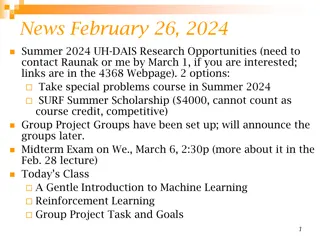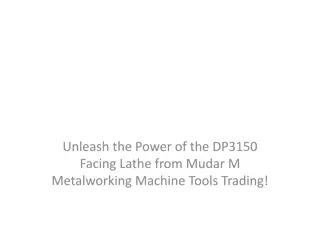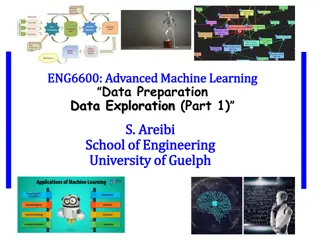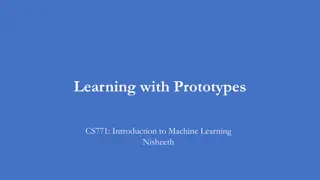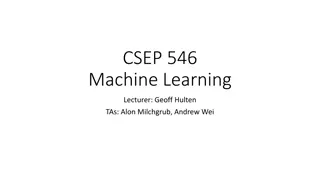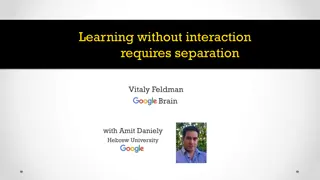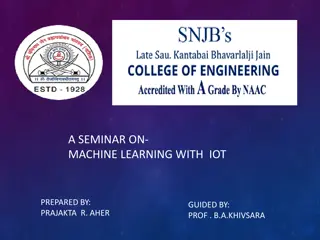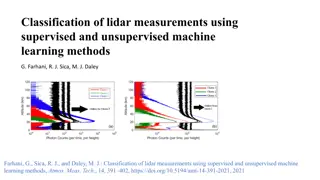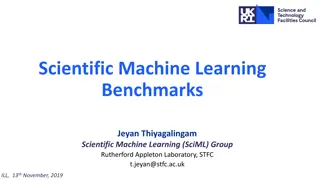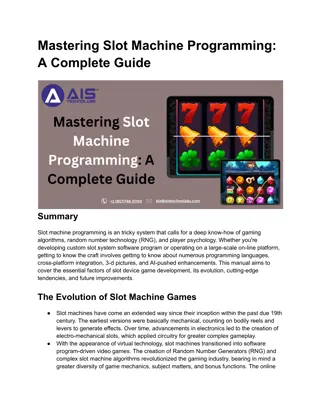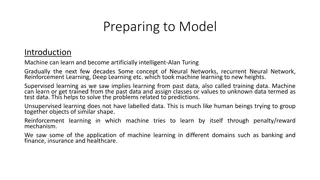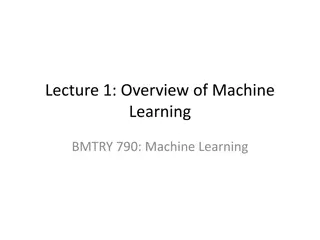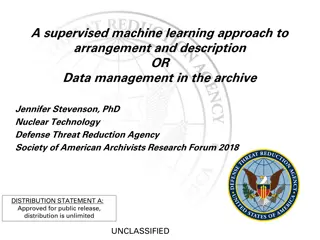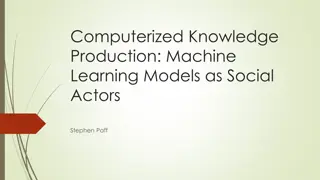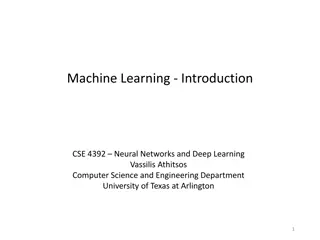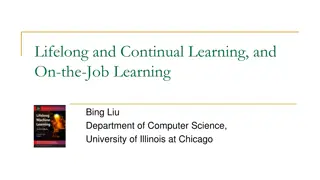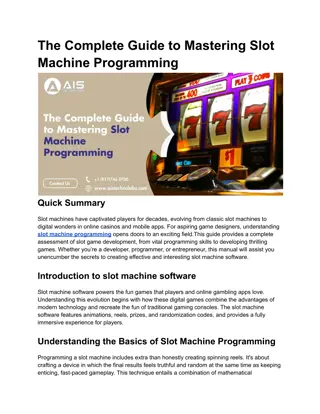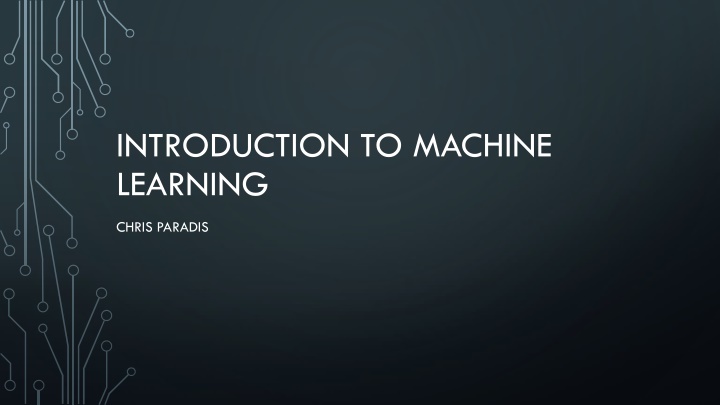
Machine Learning: An Overview by Chris Paradis
Dive into the world of machine learning with insights from Chris Paradis. Learn about the difference between machine learning and statistics, explore the relationship between machine learning and AI, and discover different types of machine learning problems like supervised and unsupervised learning.
Download Presentation

Please find below an Image/Link to download the presentation.
The content on the website is provided AS IS for your information and personal use only. It may not be sold, licensed, or shared on other websites without obtaining consent from the author. If you encounter any issues during the download, it is possible that the publisher has removed the file from their server.
You are allowed to download the files provided on this website for personal or commercial use, subject to the condition that they are used lawfully. All files are the property of their respective owners.
The content on the website is provided AS IS for your information and personal use only. It may not be sold, licensed, or shared on other websites without obtaining consent from the author.
E N D
Presentation Transcript
INTRODUCTION TO MACHINE LEARNING CHRIS PARADIS
ABOUT ME MS Information Technology and Web Science Data Science and Analytics Data Science Intern Apple Inc. Machine Learning Intelligent prediction system for business Data Science Intern Symantec Virus Network Prediction
WHAT IS MACHINE LEARNING Machine learning is a method of data analysis that automates analytical model building. Using algorithms that iteratively learn from data, machine learning allows computers to find hidden insights without being explicitly programmed where to look.
VS STATISTICS Statistical models have a theory behind the model that is mathematically proven This requires that data meets certain strong assumptions too Machine learning uses computers to probe the data for structure Do not have a theory of what that structure looks like The test for a machine learning model is a validation error on new data, not a theoretical test that proves a null hypothesis.
VS AI Depends on who you ask Computers and systems that are capable of coming up with solutions to problems on their own Fed information needed to get the solution and use it to come up with a solution on its own without explicit training
WHAT CAN YOU DO WITH IT? Three Types of Problems Supervised Unsupervised Reinforcement
SUPERVISED Trained using labeled examples Desired output is known Methods include classification, regression, etc. Uses patterns to predict the values of the label on additional unlabeled data
UNSUPERVISED Used against data that has no historical labels The system is not told the "right answer" Goal is to explore the data and find some structure within the data Clustering
REINFORCEMENT Algorithm discovers through trial and error which actions yield the greatest rewards. Three primary components: the agent (the learner or decision maker), the environment (everything the agent interacts with) actions (what the agent can do). Objective: the agent chooses actions that maximize the expected reward over a given amount of time.
WHY USE IT? Machine learning based models can extract patterns from massive amounts of data which humans cannot do because We cannot retain everything in memory or we cannot perform obvious/redundant computations for hours and days to come up with interesting patterns. Humans can typically create one or two good models in a week; machine learning can create thousands of models in a week (Thomas H. Davenport) Solve problems we simply could not before
USE CASES Email spam filter Recommendation systems Self driving car Finance Image Recognition Competitive machines
TYPICAL MACHINE LEARNING PROCESS Source: INTRODUCING AZURE MACHINE LEARNING, pg. 5
TO GIVE CREDIT, OR NOT TO GIVE CREDIT You are asked by your boss while working at Big Bank Inc. to develop an automated decision maker on whether to give a potential client credit or not.
WHAT IS THE QUESTION? What question are we trying to answer here? What problem are we looking to solve?
SELECTING DATA Feature An individual measurable property of a phenomenon being observed Best found through industry experts
SELECTING DATA Feature Extraction Feature extraction is a general term for methods of constructing combinations of the variables to get around certain problems while still describing the data with sufficient accuracy. Analysis with a large number of variables generally requires a large amount of memory and computation. Reducing the amount of resources required to describe a large set of data
SELECTING DATA PCA (Principal Competent Analysis) We have a huge list of different features Many of them will measure related properties and so will be redundant Summarize with less features
PREPARING DATA Cleaning Units Missing Values Metadata
DEVELOPING MODEL What is the problem being solved? What is the goal of the model? Minimize least squared error on the training data Training data is the data used to train the model (all of it but the part we removed)
DEVELOPING MODEL Linear Model Relationships are modeled using linear predictor functions whose unknown model parameters are estimated from the data Complex way of saying the model draws a line between two categories (classification) or to estimate a value (regression) Linear regression the most common form of linear model
DEVELOPING MODEL Non-linear Model A nonlinear model describes nonlinear relationships in experimental data The parameters can take the form of an exponential, trigonometric, power, or any other nonlinear function
DEVELOPING MODEL Overfitting Fitting the data more than is warranted Leads to a smaller error in our data set (Ein) but a larger one on data outside of our training data (Eout)
DEVELOPING MODEL Rule Addition Minimize least squared error on the training data (Ein) AND make sure that Eout is close to Ein
DEVELOPING A MODEL Keep it Simple Go for simpler models over more complicated models Generally, the fewer parameters that you have to tune the better Cross-Validation K-fold cross validation is a great way to estimate Eout Regularization Can sometimes help penalize certain sources of overfitting. LASSO Forces the sum of the absolute value of coefficients to be less than a fixed value Effectively choosing a simpler model
DEVELOPING A MODEL Data Snooping If a data set has affected any step in the learning process, its ability to access the outcome has been compromised Experimenting Reuse of the same data set to determine quality of model Once a data set has been used to test the performance of a data set, it should be considered contaminated Source: Learning From Data, pg. 173
DEVELOPING A MODEL Random Forest SVM Linear Regression Kmeans clustering K nearest neighbor Na ve bayes Neural Networks
INTERPRETING RESULTS Validation Cross validation Test set Once the test set has been used, you must find new data!
DEEP LEARNING Deep learning is usually a rebranding of neural networks Some popular use cases: Colorization of Black and White Images Adding Sounds To Silent Movies Automatic Machine Translation Object Classification in Photographs Automatic Handwriting Generation Character Text Generation Image Caption Generation Automatic Game Playing
HISTORY OF NEURAL NETWORKS Perceptrons Developed in the 1950s and 1960s by Frank Rosenblatt Classification based upon threshold
HISTORY OF NEURAL NETWORKS Marvin Minsky and Seymour Papert Proved that perceptron could not be trained to recognize several types of patterns XOR problem
HISTORY OF NEURAL NETWORKS Yann Lecun Director of Facebook AI Research Largely credited with invention of effective implementation of hidden layers
TRAIN OUR OWN ARTIFICIAL NEURAL NETWORK PREDICTING SUCCESS OF MACHINE LEARNING TALK
CONCLUSION ML can solve numerous problems Deep learning can solve even cooler problems Take Malik s course if you are interested!

